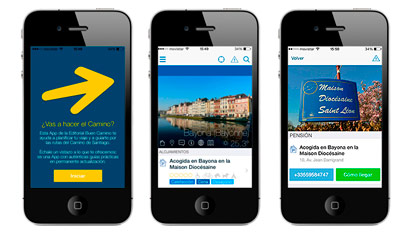CAMINO DE SANTIAGO
A great travel guide to help you plan your trip to enjoy El Camino
The Camino de Santiago has long been a challenging physical and spiritual journey that people of all walks of life have undertaken to achieve enlightenment and “test their metal”. The walk takes days to complete on foot and can be grueling at points, but the connection to nature and to one’s inner voice that you will experience is well worth the effort.
As we will see in this article, The Current iteration of the Camino de Santiago (Santiago’s path) is in fact a collection of different pathways that wind through the Iberian peninsula, all ending up in Santiago de Compostela in Galicia, at the magnificent Cathedral of Santiago in Spain. This being said let’s get into the definitive guide to the Camino de Santiago.
Camino de Santiago planner - Contents
What is the Camino de Santiago?
The Camino de Santiago is the name of a series of Christian pilgrimage routes of medieval origin that all end up at the tomb of Santiago el Mayor, located within the cathedral of Santiago de Compostela (Galicia, Spain).
Nowadays the original “Camino de Santiago” is known as the “French Camino de Santiago”. This original path starts in the western Pyrenees and runs across northern Spain until reaching the Galician city.
Today the Camino de Santiago is actually comprised of several different routes, that are the original Jacobean routes.
Santiago el Mayor was one of the 12 apostles of Jesus Christ and the first of them to die as a martyr. Christian tradition indicates that his body was transferred to Hispania ( Spain) and deposited in a tomb located in Gallaecia. This tomb was discovered around the year 820 among the remains of an abandoned Roman settlement. A temple was built on the site and expanded over the following centuries to become the current cathedral.
The adoration of the apostle soon spread among peninsular Christians and was proclaimed by Alfonso II as patron of the kingdom of Asturias, a consideration that he maintained in the political entities that succeeded his rule. Likewise, a custom arose among his armies to invoke the name of Santiago before to go into battle
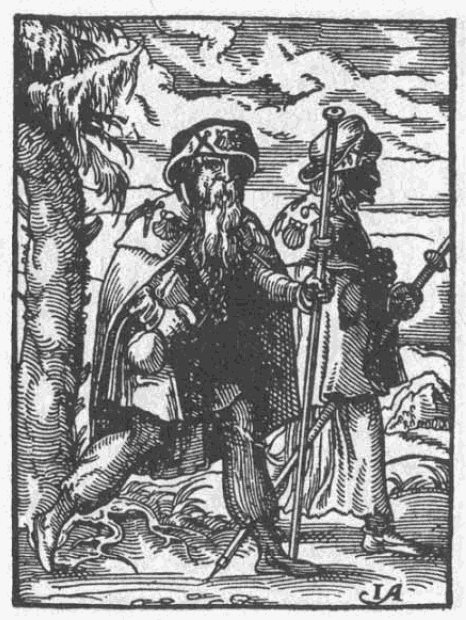
El Camino Francés
The French Way of 775 kilometres unites towns of Saint Jean Pied de Port and Santiago. It was recuperated in 1971 and has signals on the whole path, with 112 hostels and 4 shelters.
It is the longest 750km route that unites Europe with the north of Spain: Aragon, Navarra, Rioja, Castilla, Leon y Galicia and ends at the medieval men “End of the world”.
The Camino de Santiago is commonly known as the French way or Royal way that comes from Somport (Aragon way) or Roncesvalles (Navarra way). Both ways unite in the hermitage of San Salvador in the Obanos town “where the paths make one”, and not in the Queens Bridge like it is said. Having said this, there are many other “Caminos”. You can learn below about the different itineraries to enjoy el Camino de Santiago.
The French way is the path that came a few years after the appearance of the Apostol’s Body and it was converted in the Xth century in the main pole that consolidated the Empire of Alfonso VI and Alfonso VII, which permitted the normalization of the cult brought by the Cluniac’s facing the Spanish Mozarabic church.
It is a big commercial route that founds and makes cities grow: Jaca, Pamplona, Logono, Burgos, Carrion de los Condes, Leon, Astorga, etc. Most importantly, is it a big spiritual path, popularized by the Calixtinus de Aymeric Picaud Cortex, that attracted millions of pilgrims during the Middle Ages, even though during the Renaissance, the French way suffered a large decline, until almost erasing itself in the midst of time.
The French way is composed of 31 legs that go from the first 22km of adaptation days to 38km that make up the last leg of the arrival to the city of Santiago de Compostela.
Distances of the different routes in El Camino
There are several different answers to this question, as there are several different pathways to the Camino de Santiago.
- Camino Francés The original Camino de Santiago, now known as the Camino Francés or the French way, is the longest and most traditional option. This path is 940 km long and is divided into 37 different stages. 585 miles.
- Camino del Norte The next longest path is the “Camino del Norte” or the Nothern Way, that also runs along the North of Spain, slightly closer to the coast than the Camino Francés. The Camino del Norte is 869 km long and is divided into 35 different stages. 540 miles.
- Vía de la Plata.The Vía de la Plata, or the Silver route, goes from Seville in Andalusia to Astorga in Castilla y León, before meeting up with the main path. It’s 705 km long and has 26 stages that will take you on an amazing journey where you will be able to see the contrasts between northern and southern Spain. 438 miles. This is the route that the pilgrims of south western and central peninsula take. Which is one of the longest jubilee path. From Seville you walk on the roman path towards Merida, Caceres, Salamanca and Zamora. From there, you could go towards Astorga, where it unites to the Roncesvalles Camino. The Eastern Andulcian pilgrims also took the Route of Silver, the Granada path and the Cordoba path that unite with the Merida one.
- Camino Sanabrés The Camino Sanabrés is 368 Km and has 13 stages. This path will take you from Granja de Moreruela all the way to Santiago de Compostela. 228 miles.
- Camino Catalán por San Juan de la Peña. There is the Camino Catalán por San Juan de la Peña. This portion of the path will take you through 325 km of Catalonia and Aragón before linking up with the Camino Francés in Santa Cilia de Jaca. This path has 14 stages and starts at the Monastery of Montserrat. So 201 miles extra added to the Camino Frances.
- Camino Vasco. The Camino Vasco or the Basque route will take you through 205 km of northern Spain, from Irún, in the Basque country, near the border In La Rioja, where it joins the Camino Francés. This path has 8 stages. 127 miles before it joins the Camino Frances
- Camino Inglés. The Camino Inglés or English way starts either in Ferrol or in A Coruña in northern Galicia, the choice is up to you. This path was traversed by English pilgrims that sailed into the ports of Ferrol and A Coruña from England and set out from there to Santiago. The longest version of this path is 155 km and has 7 stages. 96 miles.
- Camino Portugués. The Camino Portugués or Portuguese way is similar to the English way, as it follows the path taken by Portuguese pilgrims to Santiago. It is 119 Km long and has 6 stages. It will take you from the town of Tui in Portugal, directly to Santiago de Compostela. 73 miles.
- Camino Baztanés. Camino Baztanés is 109 Km and has 6 stages. It goes from Bayonne in France down to the medieval city of Pamplona where it joins the Camino Francés. 67 extra miles.
- Epílogo a Fisterra. Lastly, the Epílogo a Fisterra goes from Fisterra in western Galicia and goes directly to Santiago. this path is i15 km long and gas 5 stages. 71 miles.
- Camino de San Salvador. The Camino de San Salvador goes from Oviedo to the capital of Castilla y León, León, and joins the Camino Francés there. This way was popularized in 1075 when a plethora of relics were discovered in the cathedral of Oviedo, and the expression:
"He who goes to Santiago / And not to San Salvador / Serves the servant / And forgets the Lord"
Unknown Tweet
There are other paths, most of which ultimately link up with one of the main paths of the Camino de Santiago but these are the main, recognized Jacobin paths. Below you will find a map of the different paths that wind across the Iberian Peninsula.
Map with the different routes to enjoy El Camino
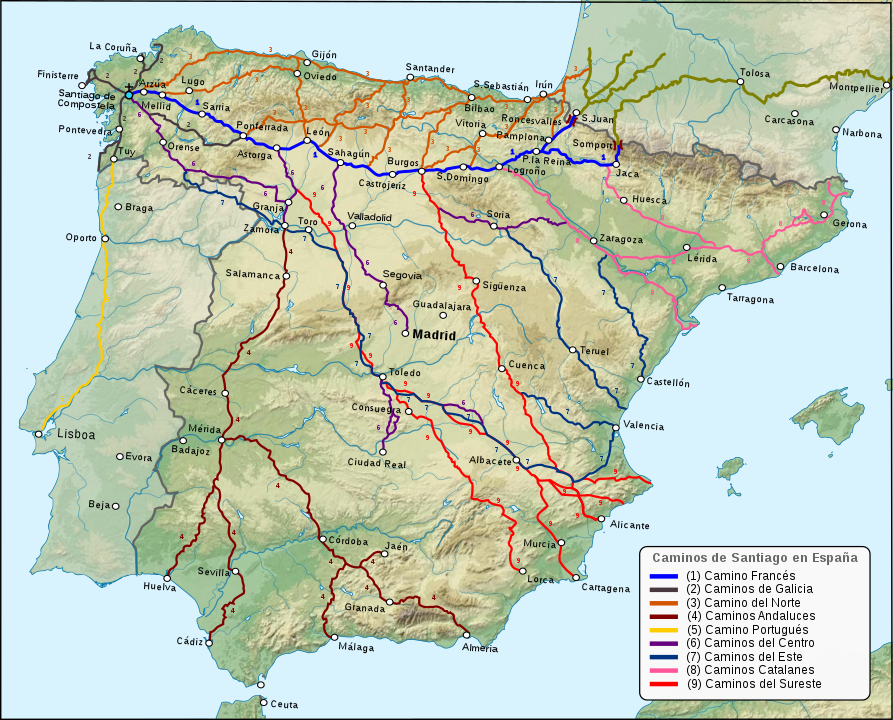
Preparing for el Camino - Tips
We recommend at least a 3 month training plan to get ready for El Camino. This are the steps to follow on each of the months
First of all, as one of your preparations tips for the Camino, it would be best if you could walk to work if it is possible. This would be the best way to start your training. You could also improve your physical health state and grain stronger leg muscles by using the stairs instead of the elevator.
- First month. During the first fifteen days, four times a week, you should go hiking without a bag pack on flat surfaces. Start with 1h hikes and gradually build up to 2h30 hikes, all this at your rhythm. For now you should concentrate on gaining muscles and building up your stamina. Before your hikes try to do exercises that activate your joints like your neck, shoulders, waist, knees and ankles. Don’t forget to stretch after your hike to relax your muscles and improve your flexibility. During the next 15 day, continue with these Camino tips but try to vary the paths your take and try to add more duration to your hikes. Try to vary flat surfaces with ups and downs. After the first month you will be able to walk on any path for three hours with no problem at all.
- Second month. Try and do three long walks during the week and use the week end to more attainable hiking paths. Start with routes that are 1 or 2 hours long to finish with routes of 3 to 4 hours, with the shoes and bag you will be going to take on the Camino de Santiago.
Hydration is very important during long hikes as well as eating correctly during these long lasting trips.
- Third month. The last few weeks before facing the Camino tour, keep sticking to your previous hikes but this time, try to hike up mountains with a slope of 500m or more, take it slowly, but it will add to your training making your feel more confident both physically and mentally so that your can fully enjoy your Camino tour.
You should also think about your posture when you walk, standing up straight and looking forward, leaving your hands free for a more natural walk. If it path is long, you can help yourself with a walking stick or too to reduce the strain that is put on your legs and knees
App to plan El Camino
Differences between the pilgrim certificate and the Compostela
The pilgrim certificate is not the Compostela (this last document is many teams wrongly named “La compostelana”) .
The pilgrim certifcate is the document that gets stamped along El Camino. It can be obtained at the Albergues, Cofradias or churches. This document is your “passport as a pilgrim” and the one that certifies you stop at different “stamp points”.
The Pilgrims office is a place of welcome and reception for the pilgrims that arrive in Santiago de Compostela that have walked or have come by bike or horse to the Tomb of the Apostol Saint James.
Here is where your final Camino stamp in stamped, in the Cathedral of Santiago, in the “pilgrim credentials” and where you get the traditional pilgrim certificate known as the “Compostela”.
Prerequisites to obtain La Compostela: on top of having done the journey for spiritual or religious reasons, you need to do at least the last 100km by foot or the last 200km by bike or by horse, which would evidently demonstrate the “ pilgrims credentials” stamped along the journey.
The Office of the Pilgrim can be found next to the Cathedral, it is open almost every day of the year form 10am to 7pm, except of Christmas and New Year’s. It’s located on Rua do Vilar, adjacent to the Platerias Plaza. In the Calle Rua do Villar, 1/3 (Telephone: 0034 981 568 846).
Since the pilgrimage to Saint James tomb that appeared spontaneously though out the IX and X century, was made official, acquiring social and religious considerations, it was important to acknowledge and confirm those who had done it.
For this, first, they used the emblem that could only be acquired in Santiago consisting of the scallop or the scallops shell. But this was easy to forge. It was decided to use the written letters that were sent in the XIII. These letters are the direct origin of La Compostela.
Presenting La Compostela, the pilgrims acquired the right to be lodged for free for three days in the Royal Hospital Foundation, an actual Parador.
Once your Compostela has been stamped you may well be ready to enjoy a well-deserved! meal at one of the many restaurants in Santiago which specialise in Galician traditional food (seafood, empanadas, octopus, padron peppers, tarta de Santiago, albariño wines….)
The pilgrim´s Mass
From the moment you leave, and during your whole trip, you can assist to what is called the “pilgrims mass” in a lot of the towns that you will go through, a service with be held normally at 8pm if there are mass officiants available. These Pilgrim masses are especially destined for pilgrims. The accompanying priest can also join the celebration and salutations are specifically given to groups.
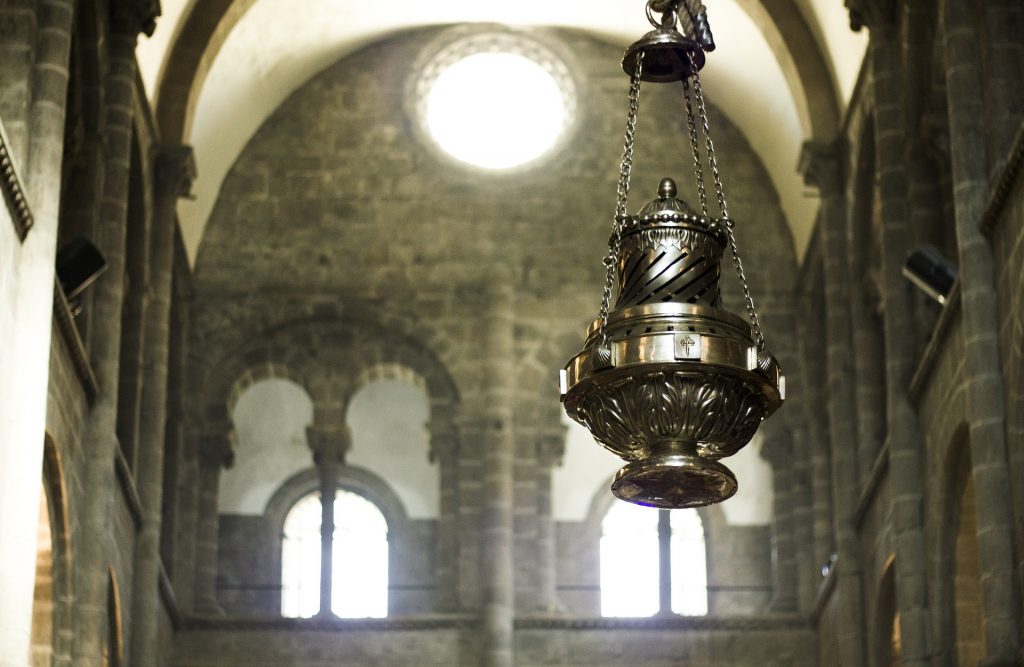
Once the pilgrims arrives in Santiago, and if his pilgrimage was spiritual and religious, he can attend the “pilgrims mass” celebrated every day at 12pm.
During the celebrations of the pilgrim’s mass in the Cathedral of Santiago de Compostela, you can notice, in some established occasion, the use of Botafumeiro, a meter and a half high and 53kg gigantic essence burner placed in the central nave of the church. The activation of the Botafumeiro can be achieved by donations made from groups, even though the church will maintain its activations to 25 occasions, the rest of the year, another, much smaller essence burner is used: “La Alcachofa” or “The Artichoke”.
In this Holly Mass, pilgrims from different places, with different languages come together around the Lords Table, of his Eucharist, after having embraced the Apostol and visited his Sepulcher.
The anticipated embrace of the Apostol
Once in the Main Altar, by walking on the right side, you will be able to go up and embrace the image of the Apostol that presides the church.
Thank you Saint James, my friend and brother, for helping me to arrive here! Thank you for being with me, for your witness to the Gospel and for your legacy!”
Santiago’s Sepulcher
Under the crypts vault, lies the true finish line of the Camino: the walls of the ancient tomb and in the middle the urn that contains the remains of the Apostol.
“And you are here, Saint James, in this far off land. You are here to preach the risen Christ, to encourage our search and our faith. Strengthen my faith and my Christian life, which many times seem to leave us. You are the strong one, the intrepid, the Son of the Thunder.”
The Pilgrims prayer
“Apóstol Santiago, elegido entre los primeros, tú fuiste el primero en beber el cáliz del Señor y eres el gran protector de los peregrinos: haznos fuertes en la fe y alegres en la esperanza, en nuestro caminar de peregrinos siguiendo el camino de la vida cristiana y aliéntanos para que, finalmente, alcancemos la gloria de Dios Padre. Amén.”
“Saint James Apostol, chosen amongst the first, you were the first to drink the Lords chalice, and you are the great protector of pilgrims: make us strong in faith, happy is hope on our pilgrim journey following the path of Christian life and sustain us so that we may finally reach the glory of God our Father. Amen.”
The end of the Camino turns into the beginning of a new life that begins at the exit of the Cathedral.
Ways to enjoy El Camino

By foot
It is very normal for a person who wants to prepare for the Camino should think about whether to do it alone or accompanied; we would answer that, alone, you wouldn’t have to depend on anybody to make decisions, plus, there will never be a moment when you are completely alone, you will be able to fully enjoy this experience and do the needed soul searching. The Camino de Santiago tour is very safe so there is no real danger. The paths are well indicated and, other than in extreme winter weathers, you will be sure to find other pilgrims in front or behind you that can help you out if needed.If you decide to take the walking tour, don’t worry, you will find company for sure.
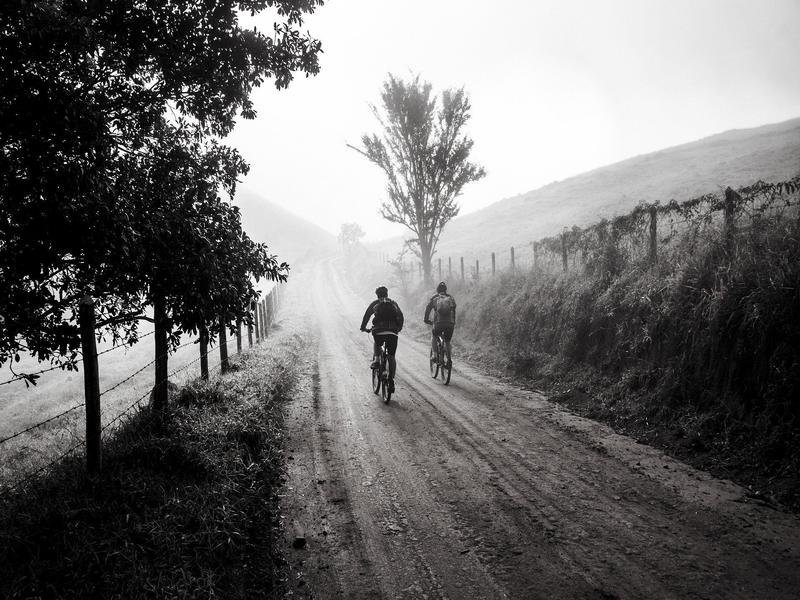
By bicycle
On the opposite of walking, pilgrims decide to get the pilgrim´s certificate enjoying El Camino by bike (with the dependence you have on the bike and possible break downs), it could be best to be accompanied if you decide to the bike tour, if you ever need to go the extra mile to repair your bike…
You should also think about wearing tight clothes on the bike tour, with no flaps that could get caught in the bike, that offer little resistance to the wind. You should also wear bright colors so that you are seen clearly by car drivers.
You would have to be very aware of traffic, and if you are a group, you should walk in a line. There are more that 800km… It is not a race, the one cycles the best will go last, accept when there is wind.
Be aware that you should not wear a waterproof poncho because it could be very dangerous on the bike. You should also check your bike daily since it is the extension of the pilgrim.

Horseback riding
Same goes for horseback riding, it is recommended to go accompanied by other horseback riders.
Previously it is advisable to have done the Camino tour by car to arrange the places of overnight stay for the animal and that way having enough food when the horse arrives.
It is essential to have insurance for your horse, because both road traffic as well as the reaction by people seeing horse are occasions for mishaps; not to mention if the rider doesn’t pay attention to the horse, it might eat the best flower of the city or get in the middle of cereal field.
The horseback riding tour requires a more thorough preparation for the Camino tour, because you have to prepare your horse and train it and also make the appropriate arrangements for veterinary and transfer.
History of El Camino de Santiago
As we have mentioned, after the uncovering of the tomb of the Apostle Santiago in the year 820, the site became an important pilgrimage destination in Europe.
An increasing number of people made the trek during the Middle Ages for reasons of faith, as they believed that the remains of the apostle had the ability to intercede before God.
Its popularity spread among the western European kingdoms and enjoyed the support of both ecclesiastical and civil authorities. An infrastructure was created for those who made the pilgrimage that offered accommodation and assistance. The political authorities even made laws to protect pilgrims during their journey.
During its history, the Camino de Santiago has experienced two major crises:
- In the 16th century due to the type of people who traveled the Jacobean routes and the appearance of Protestant theology
- and during the process of European secularization that began after the French Revolution and the loss of the accommodation infrastructure due to the confiscations of the nineteenth century
These two threats almost caused the disappearance of the Camino, but the pilgrimage would experience a notable recovery in both popularity and infrastructure during the XXth century. The number of pilgrims arriving in Santiago has not stopped increasing since the 1990s and in 2019 it reached the highest figure since there are records: 347.578 people.

The first route that the pilgrims took to was the one that started in the capital of Asturias, Santander, passed through Lugo, and ended in Santiago de Compostela. The ancient Roman route that linked Bordeaux with Astorga through Pamplona, Burgos, and León was the base on which the classic route of the Camino de Santiago, the Camino Francés, was developed.
The routs began taking form during the reconquering of the peninsula by the Christian Kings. There were other routes that started to pop-up from various regions within the peninsula. As the Reconquest progressed, the inhabitants of the new territories under Christian rule, would start using these new pathways.
In France, four itineraries were developed to get to the Camino de Santiago. They started in Paris, from the mouth of the Rhone, as well as from the towns of Vézelay and Le Puy.
With the crisis of the Jacobean pilgrimage in the 19th and 20th centuries, the routes were abandoned. Many of them were paved for use by vehicles but there are some sections that have remained untouched.
In the second half of the twentieth century, the original route was re-established and made safer, so pilgrims wouldn’t have to use roads that were now intended for cars. An infrastructure of shelters was created as well as provide accommodation for pilgrims during the trip.
The 1990′ saw the popularity of the Camino explode which has led to the recovery of a large number of other historic routes. By the end of the 2010s, an extensive network of 286 roads are cataloged and cover a total of 80,000 km in 28 countries.
The Camino de Santiago has been a remarkable place of the meeting and cultural exchange among the population of Europe since its creation in the Middle Ages, and is said to have created a «common European conscience».
Types of pilgrims
- The pilgrims: These people are the true pilgrims, the original ones. They started the pilgrimage from their home, wherever that may be in Europe. These pilgrims take on this journey is the traditional way.
- The heroic ones: These are the pilgrims that take on a Catholic tour. They pilgrim to Rome, Santiago de Compostela, Fatima, Lourdes, Jerusalem…This pilgrimage to all these Christian sacred sites lasts for several years.
- The eternal ones: They live on the Camino going from hostel to hostel, coming and going. They try to find meaning in their life on the Camino, and start the Camino again when possible.
- The veterans: They’ve done the Saint James tour numerous times (or a few times). They usually belong to associations of the Camino de Santiago to help make the lives of the pilgrims easier whilst on the tour. For example, volunteering as hospital aids.
- “Peregrinos de pata negra”: These are the pilgrims who have done the whole Camino de Santiago by foot, starting in Spain.
- Vacational pilgrims: They prefer to do the Camino de Santiago in various stages during one or more years. They stay in hotels and have help to transport their bags. They do acknowledge the beauty of the Camino de Santiago but they renounce the essence of it all.
Types of hostels
Only on the French way, you will find around 300 of these hostels, which helps a lot when it comes to finding a place to stay overnight, this way your Camino tour will almost divided for you. The parochial hostels and the religious orders were the first to open their doors voluntarily to the pilgrims and they need to keep this philosophy in mind in order to keep the origins of pilgrimaging alive.
- Public hostels.
In some of the public “alberges”, you can give a donation on a voluntary basis that are used to for cleaning and for the overall up keep of the hostel but usually in the rest the fee is usually in between 3 and 6 euros. For the private ones, the fee is from 6 to 10 euros.
In the public hostels, it is not possible to reserve. They usually go by the law of “first come first serve” giving priority to the pilgrims that have travelled by foot. To stay in one of these “albergues” it is imperative you carry your credentials and you cannot stay for more than one night, unless you get very ill.
Public hostels also have some other rules a part from the ones mentioned above. The doors close at 10pm and the lights are off at 10:30pm. You need to leave in the morning before 8am, you cannot waste water or light and everything should be kept tidy at all times. Finally, when drying your clothes, remember only to use the available clothesline.
- Private hotels.
Since solitary pilgrims that come by foot have priority in the hostels, groups should have a backup plan and look for an alternative place to stay like a private hostel or by bringing a tent or by finding a hotel to stay in.
In the private “albergues” it is possible to reserve and it should usually be done in advance, even before you leave your home, especially in summer. With renewing the Jubilee Camino, these private “albergues” started popping up all over. From the bright room filled with bunk beds of the 90s, these accommodations can now offer you, a part from bunk bed, rooms with single or double beds. It is not bizarre now to have a room with bed sheets, a washing machine, a dryer, a kitchen with a fridge, a mini bar, Wi-Fi and even foot massager.
Out of the French Way, even though it is getting better, there is still a lack of “albergues” and you will probably have to use Hostels or Hotels. This means that you might have to deviate from your path to find a place to stay the night.
The least of your concerns should be to find hotels in Santiago de Compostela itself. There is a wide range of hostels, hotels and flats in the Galician Capital and end of El Camino.
Camino de Santiago - Video
is proudly powered by WordPress


